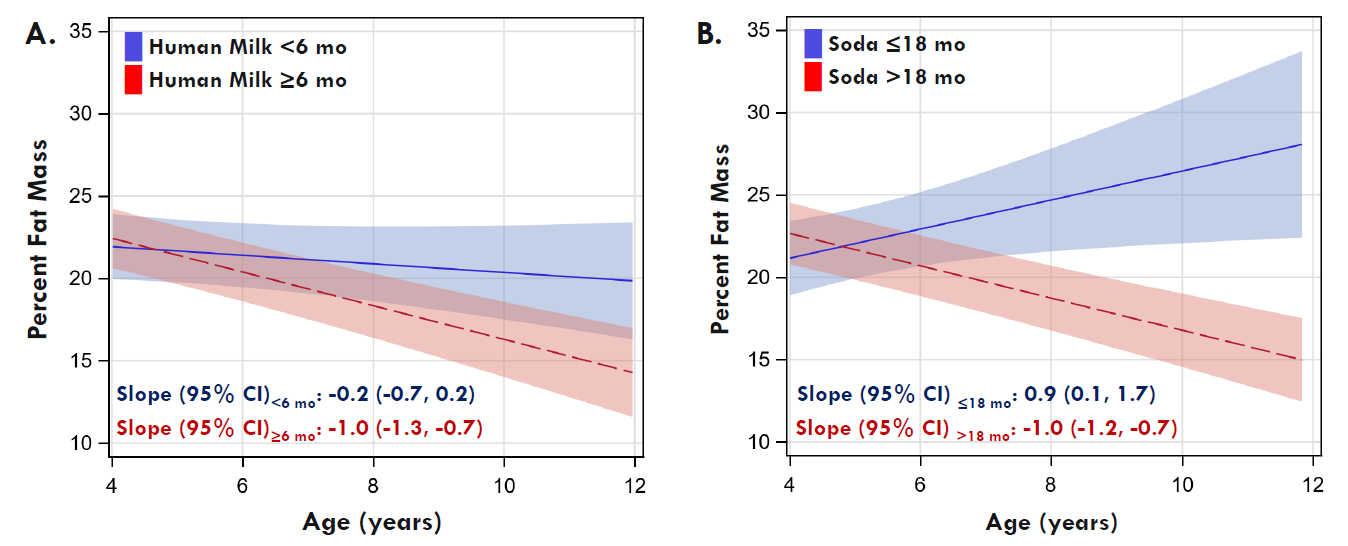New research being presented at the Annual Meeting of the European Association for the Study of Diabetes (EASD) in Hamburg, Germany (2-6 Oct) has linked infant formula and the early introduction of fizzy drinks with higher levels of body fat later in childhood.
Youngsters who were breastfed for at least six months or longer had a lower percentage of body fat by age nine compared to those who did not receive breast milk for six months (a group that includes children who were never breastfed or received breast milk for less than 6 months).
Children who were not given soda before 18 months also had a lower fat mass at the age of nine.
The finding supports the theory that how a child is fed in infancy may be linked to their susceptibility to obesity later in life.
"Numerous prior studies have examined the link between infant feeding and child overweight or obesity risk based on body mass index (BMI)," says lead researcher Catherine Cohen of the University of Colorado Anschutz Medical Campus, Aurora, USA. "However, BMI is a crude measure of adiposity in childhood. In this study, we aimed to expand on this prior research by examining associations of infant feeding practices with a more precise measure of childhood adiposity (percent fat mass).
Dr. Cohen and colleagues analyzed data on over 700 mother-child pairs participating in Healthy Start, a longitudinal cohort study into how a mother's lifestyle and environment during pregnancy can affect her child's growth and development. The mothers had an average age of 29 years at recruitment; 51% of the infants were boys.

Childhood trajectories for %FM according to (A) human milk duration, and (B) age at soda introduction. Estimates are from linear mixed models adjusted for the child’s age, sex, ethnicity, birth weight-for-gestational age z-score, maternal age, maternal education, income, parity, and pre-pregnancy BMI. Models also included an interaction term between the child’s age and the infant feeding exposure.
At interviews when their offspring were six and 18 months old, the mothers were asked about feeding practices, including the duration and exclusivity of breastfeeding versus formula feeding and the age when their children were introduced to complementary foods, a term covering solids/any liquid other than breast milk or formula. The researchers then grouped the infants according to the duration of breastfeeding (6 months or more vs. less than 6 months), age at which their baby was introduced to complementary foods (at or before 4 months or 5 months and over), age at which they were introduced to soda (18 months or more vs. less than 18 months).
Over half of the infants (65%) were breastfed for at least six months, 73% were introduced to complementary foods at 5 months or older, and 86% were introduced to soda after 18 months.
Percentage fat mass (proportion of total weight that can be attributed to body fat) was assessed twice. During the first assessment (median age of five years), it was 19.7%, on average. During the second assessment (median age of nine years), it was 18.1%, on average.
Infant feeding patterns were not associated with differences in body fat at age five.
However, shorter breastfeeding duration and early soda introduction were associated with faster increases in body fat across the two visits in childhood and, thus, a higher percentage of body fat at the age of nine.
On average, infants who were breastfed for less than 6 months had 3.5% more body fat at age nine than those who were breastfed for 6 months or more.
Dr Cohen says: "While this study cannot elucidate the potential mechanisms at play, previous research suggests that the link between breastfeeding and obesity risk may be related to differences in the nutrient composition of human milk versus infant formula. Differences in appetite regulation and the impact of the human milk on the infant's microbiome are also being investigated as potential biological effects."
The analysis also found that infants introduced to soda before age 18 months had about 7.8% more body fat, on average, at age nine than those who first tried soda at 18 months or older.
Finally, the authors also tested whether the effect of early soda introduction differed depending on whether they were breastfed for at least six months. They found that the association of early soda introduction with the rate of change for percent fat mass in childhood was similar, but slightly stronger, in children who were breastfed for less than 6 months (+1.87% body fat per year) than in those who were breastfed for 6 months or more (+1.49% body fat per year).
The child's age at the introduction of complementary foods was not strongly associated with the percent fat mass in childhood.
All of the results were adjusted for sex, ethnicity, maternal age, education, income, parity, pre-pregnancy BMI, and birth weight.
The study's authors conclude: "Infant feeding patterns, especially shorter breastfeeding duration, early soda introduction and their joint effect, may influence body fat levels later in childhood."
Dr Cohen adds: "Our findings add to the larger body of evidence supporting the potential health benefits of breastfeeding for both mothers and their children. They also support the potential importance of delaying a child's introduction to soda – an energy-dense beverage with no nutritional value during this vulnerable life stage.
"Of course, additional studies are needed to confirm whether our results are generalisable to other populations, as well."